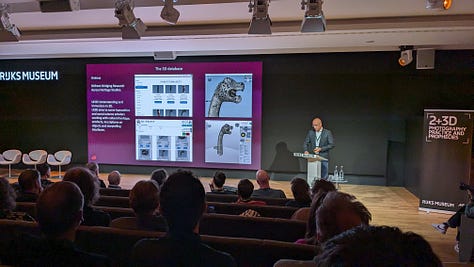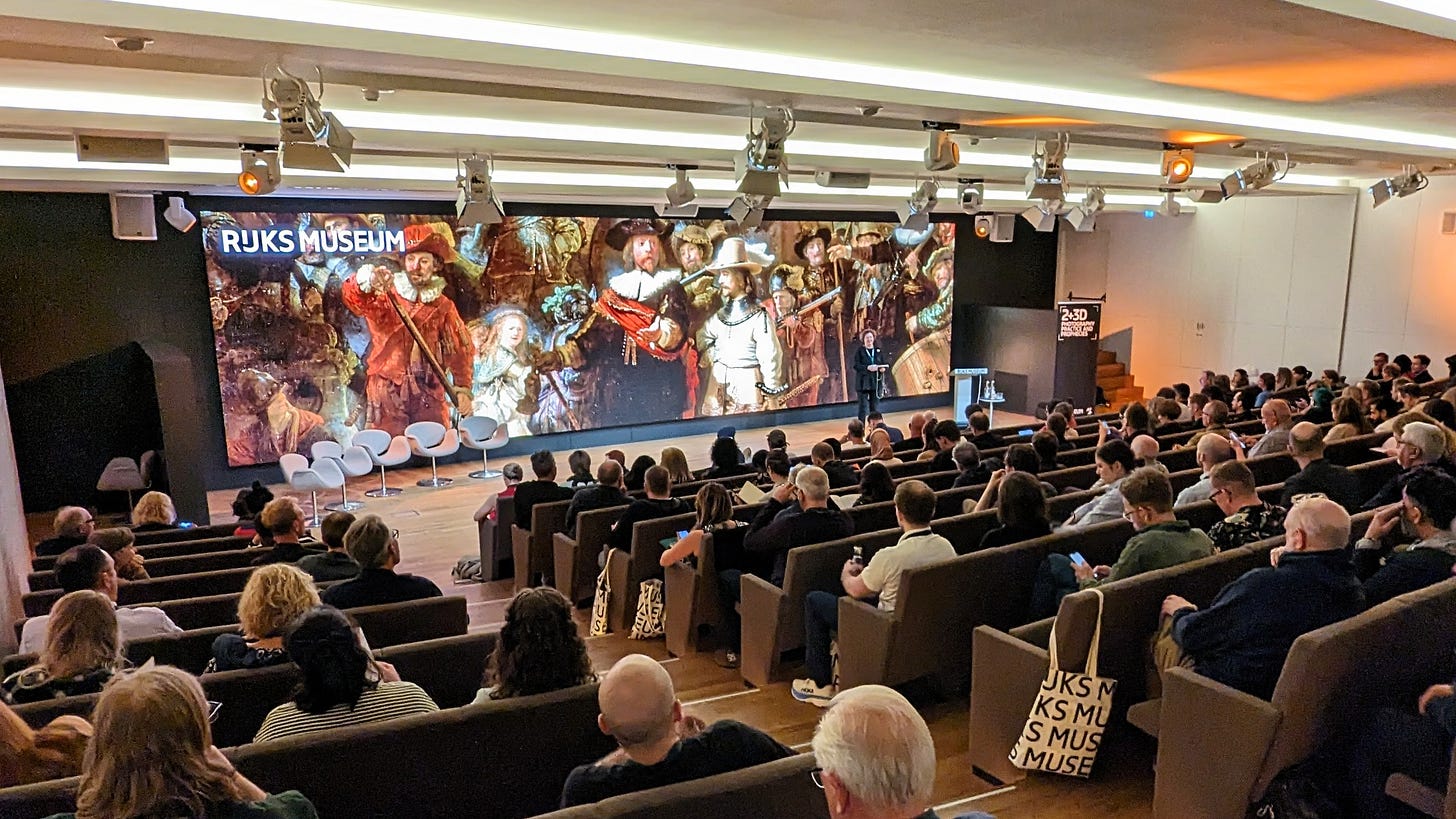Listening & Learning at Rijksmuseum's 2and3D Conference 2024
Providing a place for reflection at one of the industries premier technical seminars.
I have been on the advisory board of the Rjksmuseum’s 2and3D Photography for a few years now, helping to form the conference schedule and trying my best to bring new people and ideas into the mix. This year I was also invited to facilitate a round table discussion on the final day of the seminar in which I hoped attendees would consider the current state and future possibilities of 3D spatial content in the heritage sector.
If you’ve not heard of or been to the conference before, do check it out. As the conference’s name suggest, the focus of presentations and workshops at the event is on all aspects of 2D and 3D imaging, and as you can imagine there is a fair bit of overlap between the topics.
The event attracts some serious talent from world class organisations who are generous in sharing their professional knowledge, discoveries, and challenges with their peers. While previous 2and3D events have been recorded, unfortunately it was not possible this time around but you can get a flavour of what happened this year from these daily reports (Bonus: dorky picture of me on day 2).
Some Presentations I Enjoyed
Teams from US National Gallery, J. Paul Getty Trust, and Rijkmuseum all shared their process and rationale for digitising paintings in 3D. Each team approached the task in quite different ways, so it was great to be able to compare and contrast what was being done and why. There were also some great presentations on RTI and photometric stereo 2.5D imaging, too.



Joanne Dyer of The British Museum presented a fascinating look at research that is underway at the institution exploring in-depth 3D digitisation and visualisation which combines CT scanning (à la Francien Bossema & Co.) and multi-spectral photogrammetry (possible with the excellent Arago capture stage from Rigsters) to great effect. My ego also enjoyed the tiny shout out to some of the 3D (a stone figure of Xiuhcoatl) that I captured for the museum way back in 2014 😇



I really enjoyed presentations from staff at the University of Oslo Museum of Cultural History which grounded the requirement for high resolution 3D digitisation in the many valuable ways that 3D data can be used and re-used to serve organisational goals.



Things I Missed but Wish I’d Been There
Kira Zumkley from the V&A outlined some of the finding from Museum Exploring Expert and Non-Expert Perception of 3D Digital Models of Museum Objects (PDF), which addresses essential questions about how people understand a heritage subject via a 3D models.
Megan Dattoria and Jamie Cope from The Smithsonian provided a workshop Institution, Immersive Narratives: Best Practices for 3D Storytelling
Michael Tetzlaff, University of Wisconsin–Stout, and Charles Walbridge, MinneapolisInstitute of Art, gave a workshop on Capturing specularity with Kintsugi 3D and camera-mounted flash | GitHub
A Straw Poll
In preparation for the roundtable sessions that I was to run at 2and3D (more on that below), I wanted to gather some feedback from my professional network and posed the following question in a short survey:
What topics related to 3D digitisation and publishing in the cultural heritage sector do you think people should be talking about?
Most (80%) of the 36 respondents would not be attending 2and3D this year so I think the following data is a nice compliment to the more anecdotal information we generated during the event.
The top 10 (OK, 11 as there some a ties) topics that people felt were the most important to discuss were:
3D Digitisation Standards
3D in Conservation & Preservation
Open source solutions for 3D workflows
Staff upskilling & training for 3D digitisation / experience creation
Applications of AR / VR / XR in the cultural sector
NeRFs & Gaussian Splatting
Data Storage & Sustainability
Data Accessibility: FAIR principles / the digital divide
Storytelling with 3D
Metadata & Paradata for 3D digitisation projects
There is a long tail of other topics and you can check out the full results plus additional replies here.
Two Round Table Discussions

I ran two round table discussions on the final day of the conference, which in some ways turned into relaxed “group therapy for 3D imaging professionals” :) The sessions were intentionally very informal as I didn’t want to lead the conversation direction, ether see what was top of people’s minds. After introductions, I posed the following question to each group:
What are the current challenges for the sector, how would these be overcome in your dream scenario?
You can read the full notes here (feel free to leave your comments!), and here is a summary of some of the commonly referenced challenges and dreams:
Some Challenges
Lack of organisation and national level funding for 3D digitisation initiatives and research.
A lack of out-of-conference community and knowledge sharing amongst imaging professionals.
Lack of interdisciplinary collaboration between GLAM and other sectors/professionals.
Some Dreams
A high quality open source online 3D viewer tailored to the needs of the cultural sector (e.g. a Sketchfab functionality and ease of use, plus additional tools like scale bars, cross sections, orthogonal views, support for linked data).
‘One-click’ holistic digitisation software & hardware (e.g. capture all visual aspects of a digitisation subject: geometry, colour, transmission, roughness, etc.)
An active community of 3D digitisation specialists, developers, and creatives sharing knowledge, workflows, equipment suggestions, tips, with each other.
Some 3D
There’s always time for some guerrilla 3D scanning. Subjects from the Rijksmuseum’s collection in order of appearance in the video:
Laocoön, anonymous, c. 1695 - c. 1700 (Luma AI)
The Meeting of Joachim and Anna (RealityCapture / Sketchfab)
Amsterdam Gate Pediment (Scaniverse / Sketchfab)
15th C. Silver Service (Scaniverse)
Sustainability (or a lack thereof)
Ostensibly the theme of this year’s conference was ‘sustainability’. Outside of the opening keynote, however, as well as valiant efforts from the organising team to steer Q&A sessions in this direction, I found the theme to be largely absent from most presentations (caveat: I didn’t catch every session at the conference).
One thing I did notice as the presentations progressed—and perhaps this is to be expected in a crowd of imaging professionals—is a fetishization of “high resolution”.
During several sessions a presenter would show a distant view of a digitisation subject on the huge screen and then zoom in on some minute feature, showing it in incredible detail. This often elicited audible groans of appreciation from the audience, while demonstrations of other kinds didn’t seemed to move people in quite the same way.
Similarly, a respect for the highest resolution cameras and equipment, and a general acceptance of the necessity for producing absolutely enormous amounts of data in digitisation projects was a recurring theme in presentations.
I do not suggest that we should not celebrate high quality work in the sector, but I do think we can pause for a just moment or two to consider how capturing, processing, storing, and displaying 3D data can use up a lot of energy, and the world’s limited resources.
Speaking to an imaging expert from a world renowned GLAM organisation, we both agreed that in the context of the climate crisis the most responsible thing to do is *not* digitise things at all. But this is often at odds with goals set at organisational and national for the heritage sector. So, if we are going to digitise, perhaps we can do it more responsibly.
Off the top of my head, I present some ideas for the cultural sector to explore:
Design decision making workflows to help carefully consider if digitisation is necessary in the first place.
If we are going to digitise in 3D, consider a balance between digitising to the ‘highest resolution possible’ and ‘minimum possible digitisation activity’.
For online display, optimise output 3D based on how often it is likely to be accessed and viewed e.g. more viewed = more optimised.
Similarly, consider more sustainable offline storage options for the largest data sets.
I will admit that I am perhaps oversimplifying things here, but sometimes it can be useful to have some dumb ideas to help get a conversation started :) I’d love to hear what readers of this newsletter think about this topic, so please don’t hesitate to comment here or ping me on social channels.
Until next time!

2and3D Photography was a really thought provoking event attended by a wonderful community of talented and friendly people and the next edition will be in 2026—see you there?





